If with the action plan mapping, user story mapping, we discussed tactics, with strategy mapping, impact mapping, we address… strategy. Even before knowing how we are going to implement our product, the objective of strategy mapping is to highlight the critical paths, the key paths to validate our hypotheses. Knowing where we want to go, and which way to go to ensure as quickly as possible that the path is the right one. It’s therefore often a workshop that precedes (when necessary) the user story mapping, the action plan mapping. It’s a workshop associated with Lean Startup.
It’s a workshop that can prove to be much more difficult than user story mapping. In user story mapping we’ll find the way to describe how to implement an objective; user story mapping is more focused on something very operational. Impact mapping aims to describe what we want and what seems most important to achieve it; impact mapping is more focused on the what, why. So don’t be surprised if this workshop proves not easy to handle.
Géraldine has just written a very nice article on the subject. I recommend reading it. But in turn I’m going to approach things a bit differently (but I need to write this article for the coherence of my argument, and of my brain). I’m going to approach the workshop through questions because from my experience it’s the only way to clarify this workshop when one gets lost in it.
Question #1: Could you tell me what your product (or your project) does in two sentences and as if I were an eight-year-old child?
Naturally I’m calling here on the famous Einstein quote: If you can’t explain what you want to an eight-year-old child you don’t know what you want.
“hmm let me think…” (I’m going to continue using peetic).
“I want to create a dynamic and solid community of pet owners, mainly dogs and cats, to then be able to sell derivative products or services around these animals”.
Question #2: What would make you say that your product or your project is a success?
As with Claude’s retro-futuristic impacts presented at Raid Agile I suggest you use the “remember the future” workshop (which itself…). Push the person who must answer this question to project themselves: “we are in six months (or 3 months, or at the end of the year, etc.) you’re smiling about this success? Why? Can you describe the situation to me?”
“hmm…”
“In six months I’ve built a solid community base, and at the end of the year I’ve already made sales”.
“I’ve completed the expected features”, or “I delivered on the right date” would not have been good answers because this is absolutely not a guarantee of success.
Question #3: How can I measure this success explicitly?
Sometimes this success criterion remains very vague. You need to push the person in charge to know how to measure it explicitly. Its measurement can naturally remain a hypothesis (in fact it can probably only be a hypothesis).
“The product pleases users” could be measured explicitly by stating: “80% user satisfaction rate?” or “alternative systems are no longer used at all (0 use of alternative systems)”, or “all users connect at least once per week”.
To this measure it’s useful to add a duration. It really doesn’t matter if the person in charge pulls the measure out of a hat like magic, it’s mainly a tool to clarify the conversation afterward, but stating a measure makes the hypotheses more tangible.
For peetic, “hmm…”
“In six months I have 10,000 registered users, then every month for the next six months I have 10,000 euros in revenue”.

I’m going to focus on the first objective: 10,000 registered users in 6 months. Here there are success criteria that chain together. But very often you’ll be offered several success criteria: you must imperatively order them, prioritize them. This is the starting point of my strategy map, the OBJECTIVE. (We take a single objective per map, but we can imagine several maps).
Question #4: Who must I impact to achieve this success (this explicit measure)?
This question can be the subject of dedicated workshops as Géraldine explained well, by using personas. Following these workshops the answer here would be: The urban owner, the rural owner, the veterinarian, the animal federation… (you can find personas here: peetic). No need to include all the personas only the four, five or six most important ones (to achieve our objective).
This is the second level of the map, the WHO.
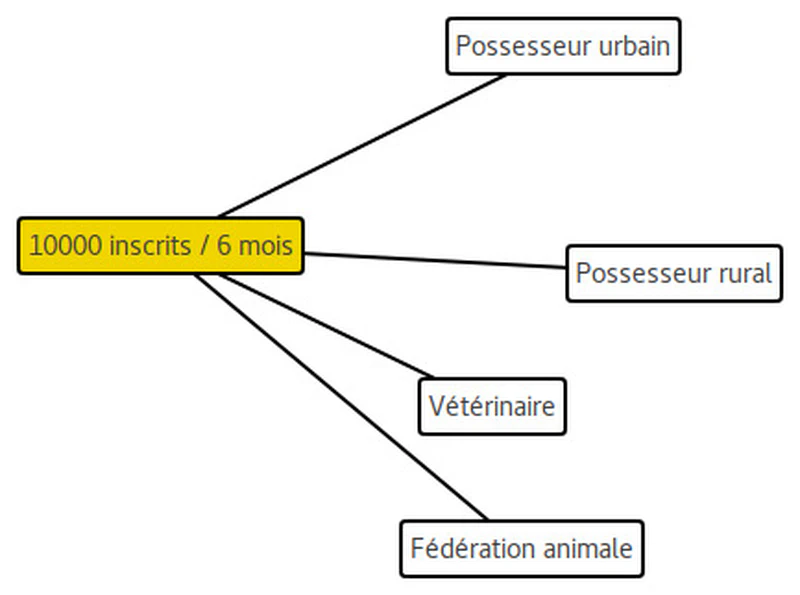 {
{
Weighting
The idea of impact mapping, of this strategy mapping, of this impact map, is to give relief, to propose hypotheses estimated as key to validate them as quickly as possible. So we’ll try to highlight these essential paths by asking the person in charge to distribute 100% across this first series of branches.
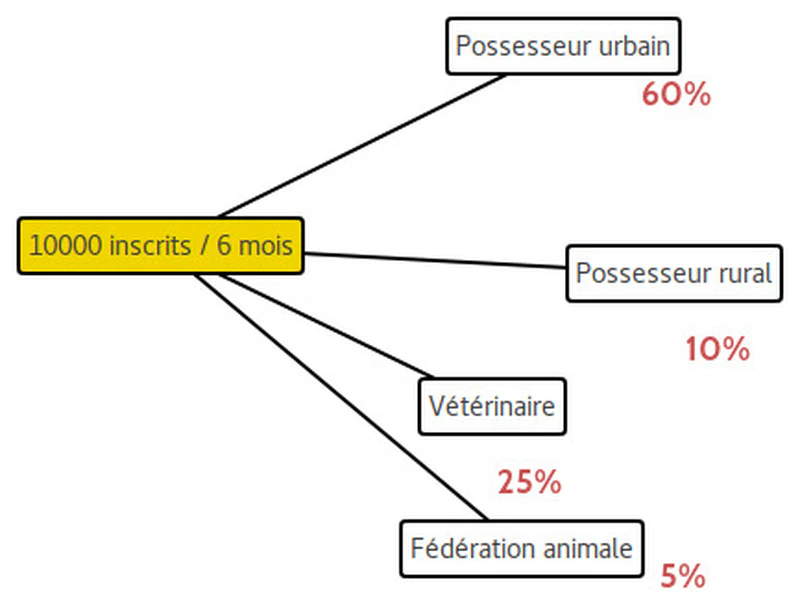
Question #5: How must I impact these people/profiles to achieve my objective?
This question is surely the most important and the most arduous. If you facilitate this workshop make the connection well by physically illustrating the reasoning to have (ah yes I didn’t specify but it’s still a workshop with stickers/post-its on the wall…): what impact must we have on this person, on this profile (you show the profile indicated on the wall), to achieve our objective (you indicate the objective).
As soon as you’ve found an impact you replay this scene; by indicating the impact you state: if I generate this impact (you indicate the impact), on this person (you show the person card), this will push toward achieving my objective (you indicate the objective).
Even more important: impacts are not means, they are impacts: usage changes, changes or new behaviors, benefits. “Receiving a notification” is not an impact, it’s a means. “Being alerted quickly” is an impact. “Making crepes” is not an impact it’s a means. “Eating one’s fill” is an impact. “Using Citymapper or Google Maps” is not an impact it’s a means. “Saving time” is an impact.
We’re not going to ask the question for each of the profiles, only those whose weighting in percentage justifies it". We’re not looking to process all paths, it’s useless, we’re looking to process the paths that seem to be essential to validate our hypotheses as quickly as possible.
This is the third level of the map, the IMPACTS.
Weighting bis-repetita
To focus on the hypotheses estimated as key and validate them as quickly as possible we’ll try to highlight the essential paths by asking the person in charge to distribute 100% across each series of branches.
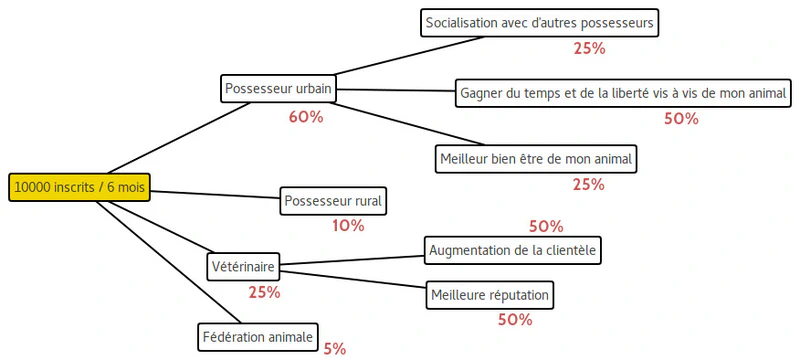
#6 What implementation for this impact is possible?
Here we fall back on something more relaxing: the next levels of my map are the HOW. I’ve processed all the impacts here because my map is small, in “real life” (where you all live but not me) it’s strongly recommended here again to focus only on the value paths. (And again the weighting).
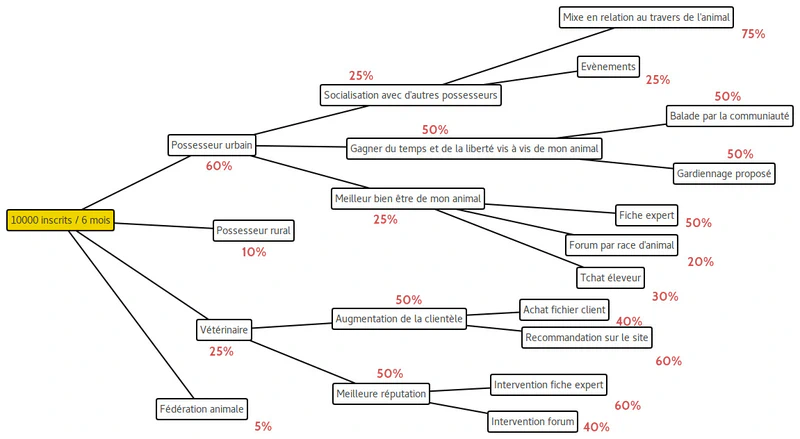
#7 Can this implementation be broken down? (option)
Don’t hesitate to break down the implementation. “Notification” can have as branches “sms”, “email”, “mobile push”, etc. Which you should also weight.
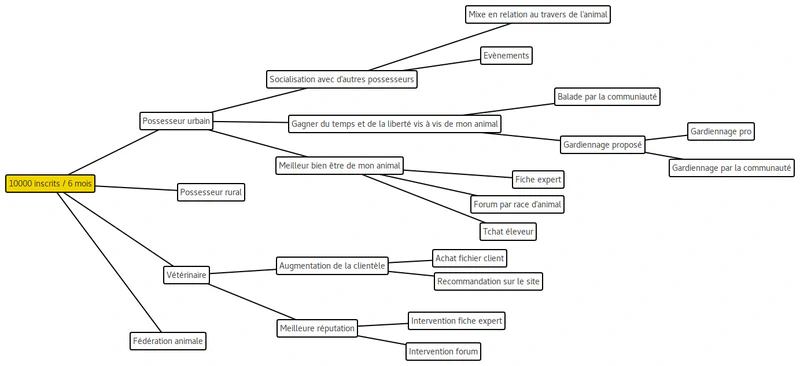
Making the hypothetical value paths to validate appear
The whole objective of this strategy mapping is to make the estimated key paths appear to validate your hypotheses as quickly as possible. If these hypotheses are confirmed: they allow you to quickly accumulate benefits, to validate your market, etc. And you continue to unfold your strategy. If they prove false, you “pivot” to use Lean Startup jargon.
The other nice benefit of this mapping is its ability to naturally propose small autonomous pieces that make sense. We give relief to our path.
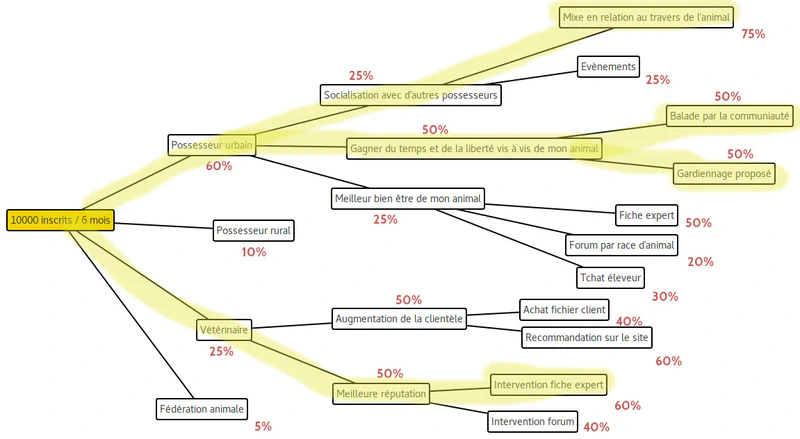
Questions are key
-
Could you tell me what your product (or your project) does in two sentences and as if I were an eight-year-old child? [VISION, CLARIFICATION]
-
What would make you say that your product or your project is a success? [OBJECTIVE]
-
How can I measure this success explicitly? [MEASURABLE OBJECTIVE]
-
Who must I impact to achieve this success (this explicit measure)? [WHO]
-
How must I impact these people/profiles to achieve my objective? [IMPACT]
-
What implementation for this impact is possible? [IMPLEMENTATION]
-
Can this implementation be broken down? (option) [IMPLEMENTATION]
Other things we could tell ourselves?
- You could have several impact maps, impact mapping per products, naturally.
- No need to duplicate branches if they are exactly the same (but perhaps depending on the “who”, the implementation would be broken down differently?).
- Above all don’t try to define all the branches, it’s useless.
- Yes, strategy mapping is not necessarily useful, it depends on your context and the progress of your reflection.
- I suggest percentages, you can more simply use stars, carambars, another weighting index.
- Sometimes it’s very interesting to turn the map from right to left rather than from left to right. Quite a few people prefer to read it this way: “if I implement this, then I’ll have this impact, on this person (this profile), and I’ll achieve part of this objective”. However we always create the map from left to right otherwise we would deduce an objective from an implementation…
What’s next?
What’s next? It’s discussing another way of doing strategy mapping with variations on the themes of the steps: “objective”, “who”, “impact”, “implementation”, variations inspired by the strategy map from agile42.
What’s next: Impact mapping off the beaten path.
What’s next is also describing the obvious connection between an impact mapping and a user story mapping, or how strategy mapping feeds action plan mapping.
One last word: Gojko Adzic’s workshop content is now freely available.